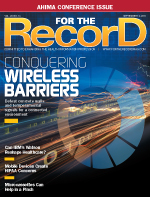 September 12, 2011
September 12, 2011
Update on Uterine Fibroids with Embolization
For The Record
Vol. 23 No. 16 P. 28
Uterine fibroids are benign uterine tumors that typically appear during the childbearing years. Also called leiomyomas, myomas, or fibromyomas, uterine fibroids vary in size and grow slowly or rapidly. In addition, a patient may have only one fibroid or a cluster of several. Uterine fibroids are classified to ICD-9-CM category 218. The following fourth-digit subcategory codes identify the location of the uterine fibroid:
• Submucous fibroids (218.0) grow from the uterine wall toward the uterine cavity.
• Intramural fibroids (218.1) grow within the uterine wall (myometrium). They are also called interstitial fibroids.
• Subserous fibroids (218.2) grow outward from the uterine wall toward the abdominal cavity. They are also called subperitoneal fibroids.
If the physician does not specify the location of the uterine fibroid, assign code 218.9.
Signs and Symptoms
In many cases, uterine fibroids are asymptomatic and are diagnosed during an annual pelvic exam or during prenatal care. However, if symptoms are present, they may include the following:
• abnormal menstrual bleeding—heavier or more prolonged than normal;
• bleeding between periods;
• abdominal or lower back pain;
• pain during sexual intercourse;
• difficult or frequent urination;
• pelvic pressure; and
• constipation.
Other conditions with similar symptoms of heavy or abnormal bleeding include endometrial polyp (621.0), pelvic inflammatory disease (category 614), endometriosis (category 617), ectopic pregnancy (category 633), and endometrial cancer (182.0).
Diagnosis
Diagnosis of uterine fibroids may require a pelvic exam to palpate fibroids, an ultrasound to evaluate the growth, and/or a hysteroscopy to examine the lining of the uterus and take biopsies if necessary to rule out endometrial cancer.
Treatment
If the fibroid is asymptomatic, typically the treatment is the “wait-and-see” approach. No surgery or medications will be ordered, but diagnostic tests continue to evaluate growth. If the fibroids are causing problems, the physician may try medications to shrink them or control other symptoms. Some common medications include the following:
• Gonadotropin-releasing hormone agonists (Lupron, Synarel) shrink fibroids.
• Progestin-releasing intrauterine device relieves heavy bleeding and pain caused by fibroids.
• Androgens such as danazol stop menstruation.
• Oral contraceptives or progestins control menstrual bleeding.
• Nonsteroidal anti-inflammatory drugs reduce heavy bleeding, pain, and inflammation.
Surgery may be necessary in the treatment of fibroids. Some of the common surgical procedures performed include the following:
• Myomectomy (68.29): the removal of uterine fibroids only, which preserves fertility.
• Endometrial ablation (68.23): laser surgery, which may be done through a hysteroscope, to remove fibroids.
• Hysteroscopic submucous resection (68.29): removal of a portion of the protruding fibroid, which preserves fertility.
• Hysterectomy: removal of the uterus. This is the most common option but only when the fibroids are causing problems. The code assignment will depend on the type and extent of hysterectomy performed. Without removal of the uterus, recurrence of fibroids is common.
If the fibroid surgery is performed via a hysteroscope or laparoscope, code 68.12 or 54.21 should not be assigned as an additional code. Only the procedure performed should be coded and not the approach (AHA Coding Clinic for ICD-9-CM, 1992, third quarter, page 12).
Uterine artery embolization (UAE) is commonly done for uterine fibroids and therefore may be referred to as uterine fibroid embolization. Typically done in interventional radiology, a physician inserts a catheter into the femoral artery, maneuvers it up to the uterine artery and injects the embolic agent into the arteries that supply blood to the uterus and fibroids. Some common embolic agents include the following:
• acrylic spheres, also called microspheres (Embospheres);
• coils;
• gelatin sponges (Gelfoam);
• particulate agent NOS;
• polyvinyl alcohol; and
• spherical embolics.
The goal of the procedure is to block the blood supply to the fibroids causing them to die.
Effective October 1, 2011, new codes created for UAE are assigned as follows:
• 68.24, Uterine artery embolization [UAE] with coils.
• 68.25, Uterine artery embolization [UAE] without coils.
Coding and sequencing for treatment of uterine fibroids are dependent on the physician documentation in the medical record and application of the Official Coding Guidelines for inpatient care. Also, use specific AHA Coding Clinic for ICD-9-CM and American Medical Association CPT Assistant references to ensure complete and accurate coding.
— This information was prepared by Audrey Howard, RHIA, of 3M Consulting Services. 3M Consulting Services is a business of 3M Health Information Systems, a supplier of coding and classification systems to more than 5,000 healthcare providers. The company and its representatives do not assume any responsibility for reimbursement decisions or claims denials made by providers or payers as the result of the misuse of this coding information. More information about 3M Health Information Systems is available at www.3mhis.com or by calling 800-367-2447.
Thinking Ahead: ICD-10-PCS and the Operative Report
The operative report must identify many aspects before a code assignment can be made. For example, during a hysterectomy procedure, the operative must specify each body part removed (uterus, ovaries, tubes). In addition, was the total or partial organ removed? The root operation resection is defined as cutting out or off, without replacement, all of a body part. Excision is defined as cutting out or off, without replacement, a portion of a body part. Codes are assigned for each body part removed. The operative report also needs to specify the operative approach (eg, open, laparoscopic, through natural orifice), laterality, and if any devices were inserted.
— Audrey Howard



